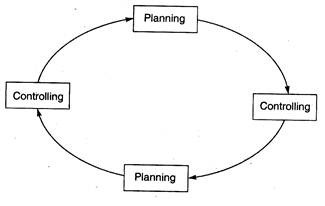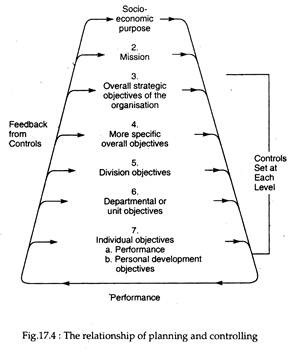There is a very close link between planning and controlling. This is shown in Fig. 17.2. This is usually the first part of the management process. In the next stage, the organising and leading functions get the actual work of the organisation done, and the controlling function is directly tied back into planning.
Fig 17.2 : The Link Between Planning and Controlling
A modern organisation continuously cycles back and forth between planning and controlling. To start with, the manager makes plans and then uses the control system to monitor progress toward fulfillment of these plans.
ADVERTISEMENTS:
The control system, in turn, tells the manager that things are in order, i.e., going as they should (the current plan should be maintained), that things are not going as they should (the current plan has to be modified), or that the situation has changed (a new plan should be drafted).
Controlling and Other Managerial Functions:
There is difference between planning and controlling. Controlling establishes performance standards used to measure progress towards organisational goals (objectives). The basic objective of controlling is to determine whether people and the various parts of an organisation are on target, achieving the progress towards their objectives that they planned to achieve.
Whereas, planning chooses goals and maps out the necessary strategy and tactics controlling attempts to prevent failure (and to promote success) by providing the means to monitor the performances of individuals, departments, divisions — and the organisation in it entirety.
ADVERTISEMENTS:
In fact, control is related to, is affected by, and affects the four other managerial functions. This is especially true of planning.
In truth, controlling complements planning. Managers often layout careful and elaborate plans, but unless these are supported by effective control, plan accomplishment becomes just a matter of luck. Organisation that do not exercise proper control even run tremendous risks. It is even thought that planning is incomplete unless good controls are also established.
Planning and controlling are so closely linked with each other that they have been called- “the Siamese Twins of management.” In fact, we shall now observe that the initial step of the control process is actually a planning step — establishing a goal, standard, or performance objective. The essence of control lies in comparing actual results with the plan.
The control function of management is also inseparably linked up with the other managerial functions as shown in Fig.17.3. It enables us to assess whether planning, organizing, staffing, and leading are being performed effectively.
Fig. 17.3 : The relationship of control to other management functions
Steps in Control Process:
We have noted that the planning process determines objectives which ultimately serve as the foundation for managerial controls. Planning, which is treated as the first function of management, is at the heart of all others. Fig.17.4 shows the relationship of planning and controlling.
It shows a big picture from the development of organisational goals to individual objectives. Prima facie, an organisation exists to fulfill certain socio-economic purpose. Then the mission of the organisation gives direction to planning and Serves as the basic purpose for the organisation’s activities.
ADVERTISEMENTS:
Thus, the strategic objectives and plans-are made at the top level of the organisation’s purpose and mission. From these plans flow the co-ordinated goals to be achieved by succeedingly low levels of management in the organisational hierarchy.
As the plans are formulated and goals are set, controls must be established to monitor the progress toward these goals. The feedback from controls is intended to provide management with information on the progress of the various levels of plans, sub-plans, goals, objectives, strategies, tactics, or individual performances.
The feedback in the control process may not only report progress as planned, it can also indicate the plans and sub-plans themselves.


